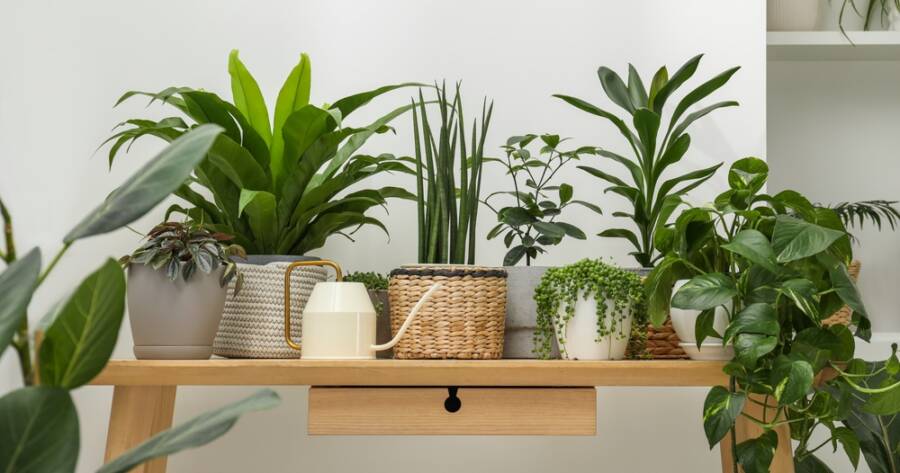Bringing greenery indoors isn’t just about aesthetics—it may also improve air quality and create a healthier living space. Many houseplants act as natural air purifiers, potentially filtering out toxins and increasing oxygen levels. However, not everyone has the time or expertise to care for high-maintenance plants. Fortunately, several low-maintenance indoor plants thrive with minimal care while actively improving air quality, making it easy to enhance both wellness and ambiance in any home environment.
Snake Plant (Sansevieria): The Ultimate Low-Maintenance Air Purifier
The snake plant, also known as mother-in-law’s tongue, is one of the best air-purifying plants that require little attention. It removes toxins like formaldehyde, benzene, and xylene from the air while releasing oxygen at night, making it ideal for bedrooms.
Why It’s Easy to Care For:
- Thrives in low light to bright indirect light
- Requires watering only every 2-3 weeks
- Tolerant of dry indoor air and infrequent watering
The snake plant’s hardy nature and ability to survive in less-than-ideal conditions make it a favorite for those with a busy lifestyle or little plant-care experience.
Pothos (Epipremnum aureum): A Resilient, Air-Cleaning Vine
The pothos plant is a popular trailing vine that grows rapidly and is nearly impossible to kill. It effectively removes toxins like carbon monoxide, formaldehyde, and benzene, helping to keep indoor air fresh.
Why It’s Easy to Care For:
- Adapts to low, medium, or bright indirect light
- Only needs water when the soil dries out
- Grows quickly, even in low humidity
Pothos plants can be placed on shelves, in hanging baskets, or trained to climb walls, making them a versatile option for improving air quality in any space.
ZZ Plant (Zamioculcas zamiifolia): The Toughest Houseplant Around
If you tend to forget about watering your plants, the ZZ plant is the perfect choice. This plant is nearly indestructible and can thrive in a wide range of indoor conditions while removing toxins like toluene and xylene from the air.
Why It’s Easy to Care For:
- Thrives in low-light conditions
- Can go up to a month without water
- Resistant to pests and diseases
The ZZ plant’s waxy, deep-green leaves give it a polished look while requiring almost no maintenance, making it a great choice for homes and offices alike.
Peace Lily (Spathiphyllum): A Flowering Air Purifier
For those who want a plant that not only purifies the air but also adds a touch of elegance, the peace lily is an excellent option. It filters out harmful toxins like ammonia, benzene, and formaldehyde while producing beautiful white flowers.
Why It’s Easy to Care For:
- Tolerates low to moderate light
- Wilts when thirsty, making it easy to know when to water
- Requires watering only once a week
The peace lily is perfect for adding a bit of sophistication to your space while improving indoor air quality with minimal effort.
Spider Plant (Chlorophytum comosum): A Fast-Growing, Air-Purifying Champion
The spider plant is another excellent low-maintenance option known for its ability to remove toxins like carbon monoxide, formaldehyde, and xylene. Its long, arching green-and-white-striped leaves give it a unique, decorative look.
Why It’s Easy to Care For:
- Thrives in low to bright indirect light
- Requires watering only once a week
- Propagates easily, producing small baby plants that can be repotted
Spider plants are resilient and adaptable, making them a great choice for anyone looking for a fast-growing, air-purifying plant that thrives with minimal attention.
Other Notable Air-Purifying Plants to Consider
Beyond the classics like the snake plant and pothos, several other low-maintenance houseplants excel at cleansing indoor air. Philodendrons are among the easiest to care for, thriving in a variety of lighting conditions while efficiently removing formaldehyde and other toxins. Their lush, heart-shaped leaves make them a stylish addition to any room. Similarly, English ivy is an adaptable climber that filters out airborne pollutants such as benzene and carbon monoxide, making it ideal for homes with fireplaces or smokers.
If you prefer plants with a tropical flair, bromeliads and dracaenas offer vibrant color and strong air-purifying qualities. Bromeliads release oxygen at night, enhancing bedroom air quality, while dracaenas thrive in low light and combat trichloroethylene—a common household toxin. For an elegant touch, consider rubber plants or areca palms, which purify the air and naturally humidify your living space, supporting both comfort and health.
Breathe Easier with Minimal Effort
Incorporating indoor plants into your home doesn’t have to be complicated. The snake plant, pothos, ZZ plant, and peace lily are some of the easiest houseplants to care for, requiring little water and light while significantly improving air quality.
These plants not only enhance your space with their greenery but also help create a healthier environment by filtering out airborne toxins. Whether you’re a seasoned plant lover or just starting out, these low-maintenance options make it easy to enjoy the benefits of indoor plants with minimal effort.

